Shall not use confluence comment, shall use Jira at https://jira.automotivelinux.org/browse/SPEC-3960
Fixed.
Table of Contents
1. Executive Summary
This document shows a design of program structure, the communication protocol, and the data of IPC between IC-Service and Cluster.
2. Indexes and tables
2.1 Change history
| Revision | Date | Author | Description |
|---|
| 0.1 | 2021/03/22 |
| New entry. |
2.2 Referenced documents
| Tag | Document name | Location of documents |
|---|
| IC-Service_API_rev0.4.docx |
|
| Size_list_of_Data_Pool.xlsx |
|
| IC-EG Architecture Overview - Draft_200803a.pptx |
|
2.3. Glossary
3. Scope
- This document is intended to be read by users of IC-Service IPC.
4. Use case
4.1. The whole system
This chapter describes the whole system including the developmental target of this document. The following picture is quoted from the system architecture, "IC-EG Architecture Overview - Draft_200803a.pptx".
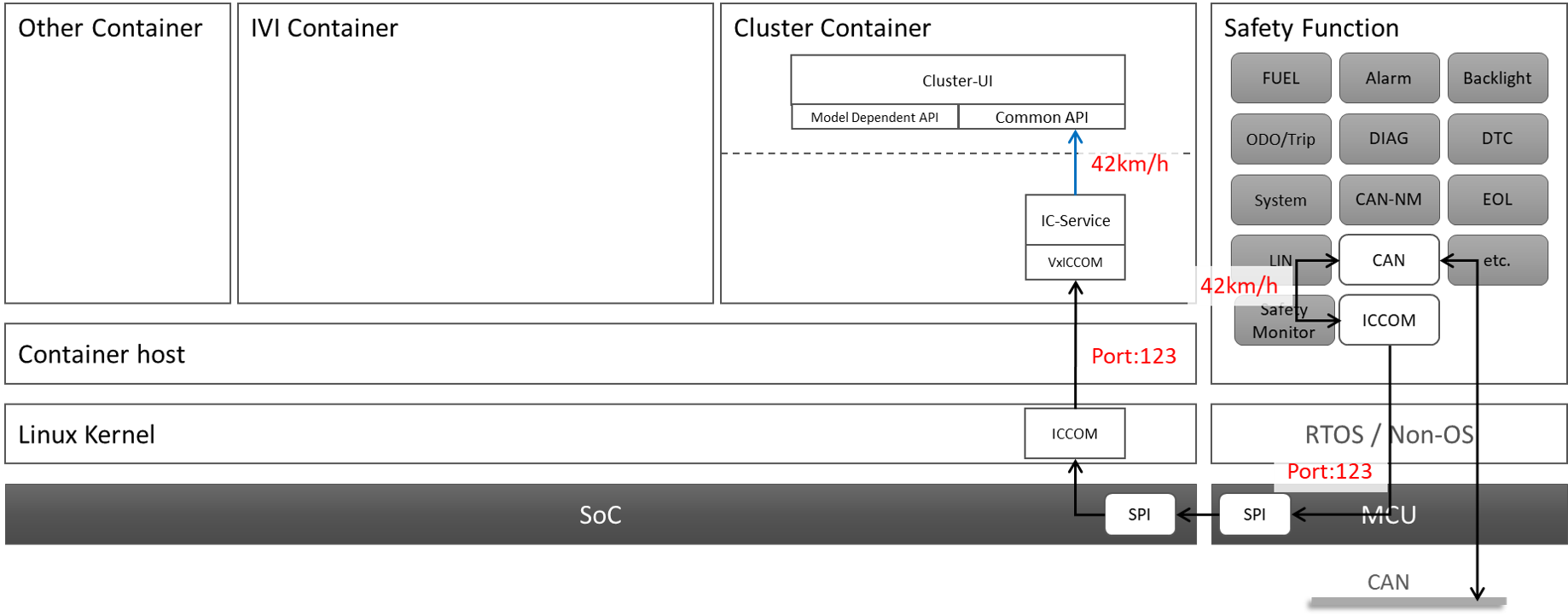
The outline of the system is following:
- This linux system has Cluster UI display and Cluster UI applications based on the vehicle information received from CAN.
- External MCU receives vehicle information from CAN and sends it to IC-Service on SoC through SPI ICCOM. This is because CAN has to be started earlier and also it is related to functional safety.
- Cluster UI reads the vehicle information from IC-Service by calling Common API.
4.2. IC-Service IPC
IC-Service IPC in the system shown in 4.1 has the following functionalities.
- Hide the implementation of communication between IC-Service and Cluster UI
- Define communication protocols for Cluster
- Abstract the CAN data received through ICCOM
Components of use cases are described in the following table.
| Component | Description |
|---|
| App | App is a part of Cluster UI. App calls API functions for Cluster. |
| Cluster | Cluster is the library provides APIs to get data of IC-Service.
It provides App the signal information received from IC-Service.たb
Cluster runs as a part of App process because it is the layer called as function from App. |
| IPC | Inter Process Communication.
This part provides functionalities to communicate to send signal information from IC-Service to Cluster or the reverse.
It has data protocols and it is designed and implemented as the divertable part used by not only Cluster and IC-Service but also other domains. |
| IC-Service | IC-Service is a part to have vehicle internal information.
It sends signal information to Cluster.
It runs as another process from App process. |

4.2.1. Use cases of sending data through IPC
IPC enables communication between client and server. Use cases of client-server communication are shown below.
4.2.1.1. One server to one client
One server can send data to one client through IPC with one domain.
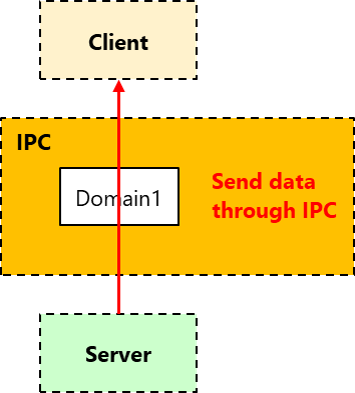
4.2.1.2. One server to multiple clients with multiple domains
One server can send data to multiple clients with different domains.
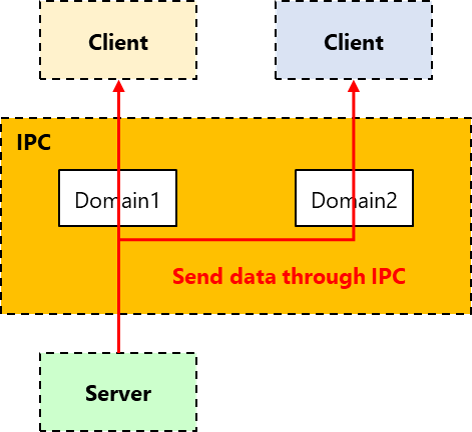
4.2.1.3. One server to multiple clients with single domain
One server can send data to multiple clients with the same domain.

4.2.1.4. Multiple server to one client with single domain
Multiple servers cannot send data to same client with the same domain.

5. Requirements
The following requirements are derived from the use cases in 4.2. and the external API specification.
- Data protocol should be scalable.
- API abstracting part should be implemented separately in order to make this part divertable.
- IPC should enable client-server communication.
- One server can communicate with one or more clients.
- One client cannot communicate with multiple servers with the same domain.
- It is allowed that One client communicates with multiple servers with different domains.
- Cluster UI in HMI Layer and IC-Service in Service Layer should communicate with IPC using Linux Domain Socket in the two ways of communication; polling and event.
- Polling Cluster UI calls getData function to get value periodically regardless of change of the value.
- Event Cluster UI registers the signal to IC-Service. When the value of the signal changes, IC-Service notifies Cluster UI with Notify function.
- IPC part should be divertable for other domains and communication protocols.
6. Architectural design
Architectual design of IPC and components associated with IPC is shown below.
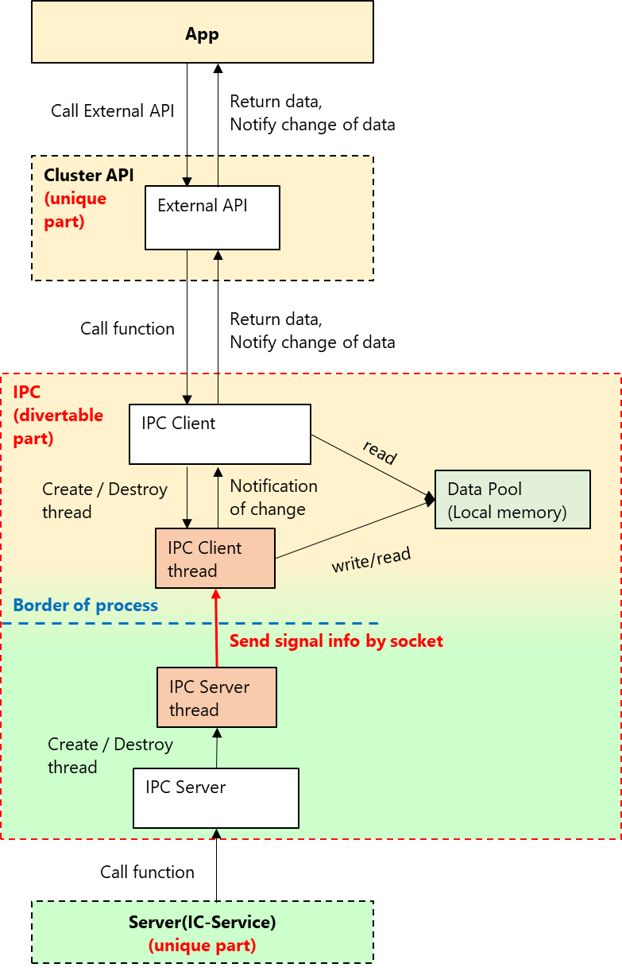
6.1. Design Consideration
6.1.1. Outline of IPC design
Outline of IPC design is shown below.
- Precondition
- IPC communicates by Unix Domain Socket.
- Use epoll for monitoring file descriptors.
- IPC part is designed to be divertable.
- IPC creates a shared library for both client and server.
- IPC has one public header file. The header is included from both client and server.
- Specification of the public header file
- The header is named as "ipc.h".
- ipc.h has the functions and macros to provide IPC functionalities for client and server.
- ipc.h includes "ipc_protocol.h".
- In ipc_protocol.h defines data protocols and Unix Domain names for all usages.
- One data protocol and one Unix Domain name are defined for each of usage.
- Client and server select one from usage defined in ipc_protocol.h
- Specification of communication and data
- Another thread for IPC communication is created in IPC. IPC Client and IPC Server communicate on the thread.
- One thread is created for one process, even in the case that multiple domains are used.
- IPC Client allocates memory for Data Pool at start of the thread.
- The client-side thread receives the data sent from server and writes the data into Data Pool.
- The data is all of the structure defined as the data protocol for the domain.
- Then client also detects a change of Data Pool and notifies client-side App of the change by callback.
- Limitation
- Communication is allowed as only one direction, sending from server to client.
- It is not allowed for multiple servers to use same domain.
6.1.2. How to define data protocol
Data sent/received for each usage and Unix Domain names for communication are defined in ipc_protocol.h. When the usage of IPC divertable part is expanded, new definition of them are added to ipc_protocol.h.
The defined items in ipc_protocol.h are as follows:
- enum definition for client/server to select an usage
- data protocols (structure) corresponding to the usage (referable from client/server)
- enum definition of data values corresponding to the usage (referable from client/server)
- size of Data Pool and Domain name corresponding to the usage (used within IPC)
- address (offset) table for checking the change of data corresponding to the usage (used within IPC)
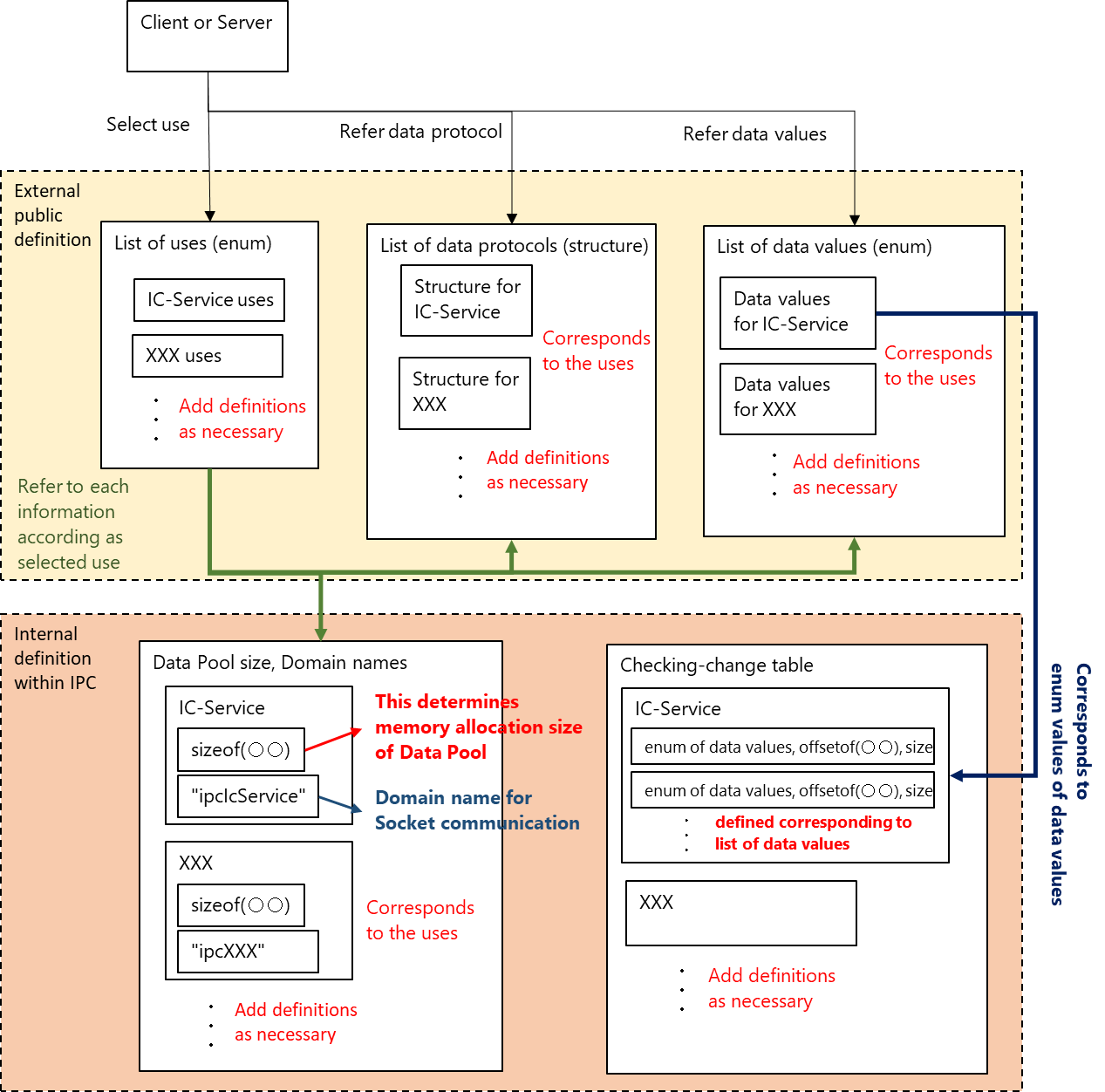
6.2. External view
6.2.1. Component structure of IPC
Source and header files in the components associated with IPC is shown below.
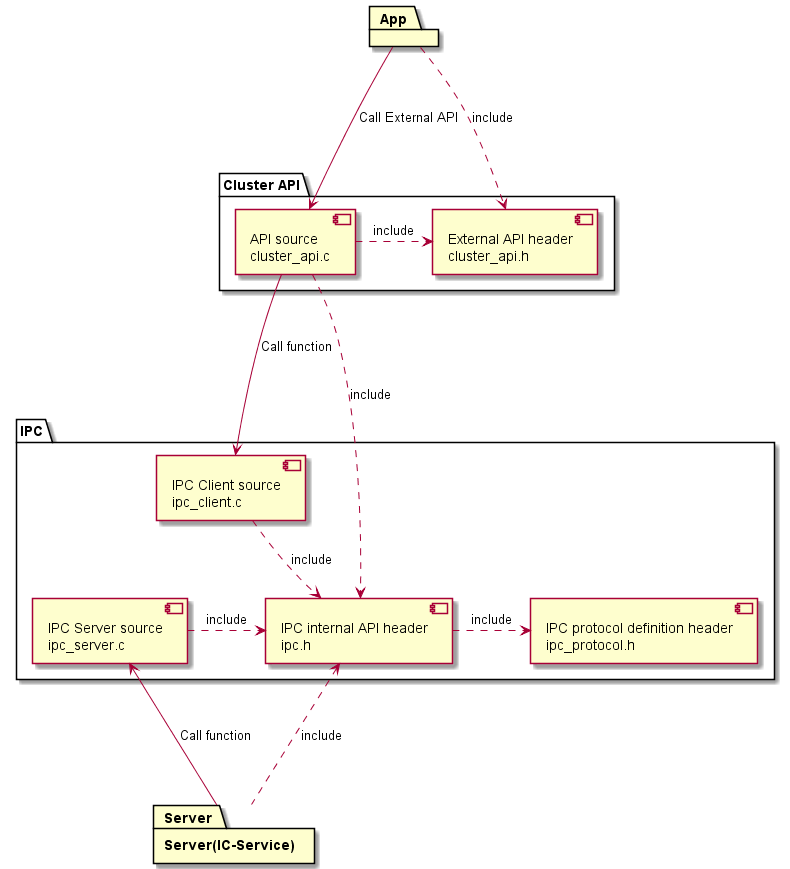
6.2.2. Inter-component sequence of IPC
This chapter shows sequences between component elements of the architecture in 6. About APIs between App and Cluster API in the sequences, refer to the external API specification. About APIs between Cluster API or IC-Service and IPC API, refer to 7.2.
6.2.2.1. Startup/Initialization

6.2.2.2. Update DataPool


6.2.2.3. Process of getter API

6.2.2.4. Register/Notify
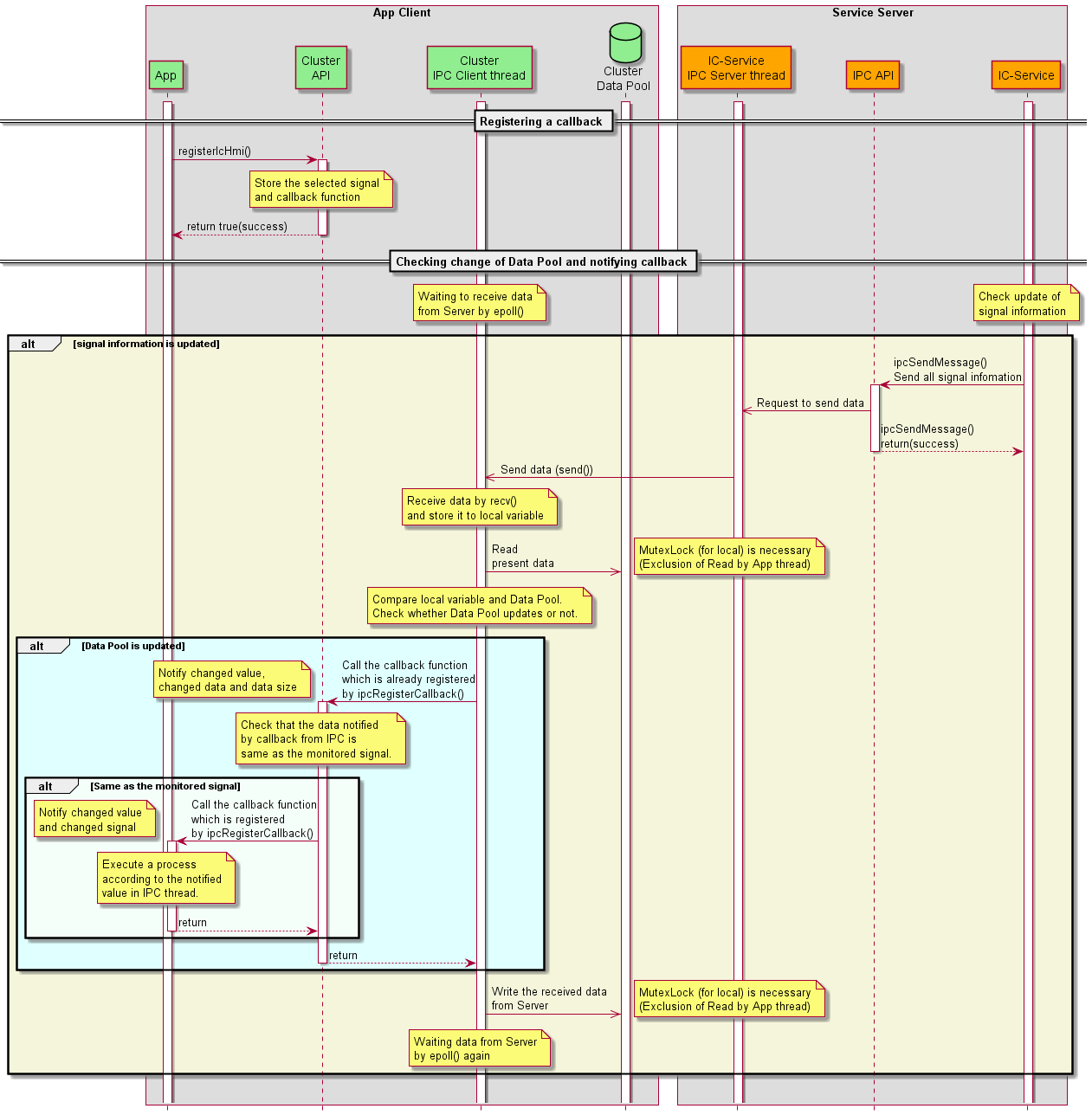
6.2.3. Pkg-config
IPC and Cluster API prepare pkg-config. Names of metadata files are the followings:
- IPC: ipc.pc
- Cluster API: cluster_api.pc
7. Interface definition
7.1. External API
Refer to "IC-Service_API_rev0.4.docx".
7.2. Internal API
IPC has the following internal apis. Details of the apis and how to use them in case of IC-Service are described in 8.2.1.
| Function name | Explanation | User | Section |
|---|
| ipcServerStart() | Start IPC Server. | Server | 8.2.1.1 |
| ipcSendMessage() | Send data to Client. | Server | 8.2.1.3 |
| ipcServerStop() | Stop IPC Server. | Server | 8.2.1.5 |
| ipcClientStart() | Start IPC Client and connect to the IPC Server which has same Domain. | Client | 8.2.1.1 |
| ipcReadDataPool() | Read the Data Pool which stores data received from Server. | Client | 8.2.1.4 |
| ipcRegisterCallback() | Register a callback function for notification of change of Data Pool. | Client | 8.2.1.2 |
| ipcClientStop() | Stop IPC Client. | Client | 8.2.1.5 |
7.3. Communication protocol
7.3.1. Communication protocol design
This chapter shows the communication data between IC-Service and Cluster.
7.3.1.1. Data and communication framework
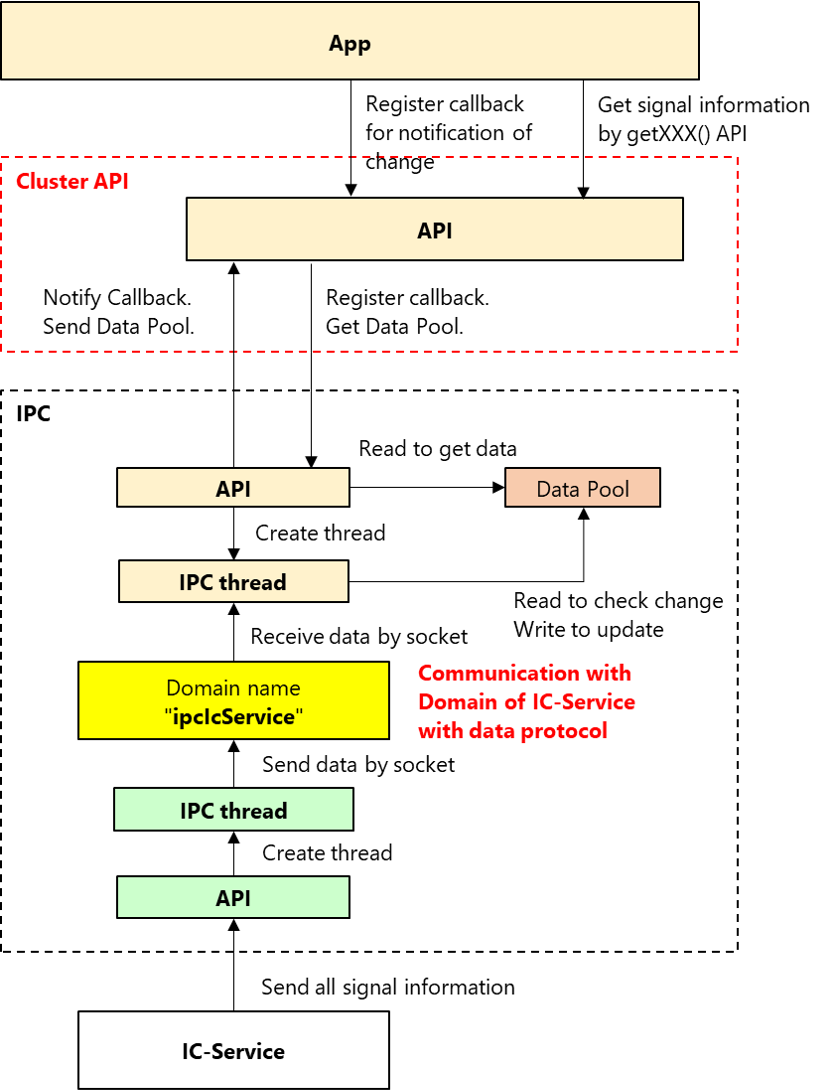
7.3.1.2. Data protocol
- The Domain name for IC-Service used by IPC is "ipcIcService" and is defined in ipc_protocol.h.
- IC-Service is Server and Cluster is Client. IC-Service sends all signal information to Cluster API.
- All signal information is entered into one structure. The structure is sent/received through IPC.
- The structure for IC-Service is defined in ipc_protocol.h.
- IC-Service sends all signal information each time, even in case that only a portion of the signals are updated.
- Sending cycle from IC-Service to Cluster is assumed to be about 10 msec as default.
- When App calls getXXX() function, App can get the data stored in Data Pool at the time.
- App can get not all data but only the data correspoinding to getXXX().
- App registers signal and callback function with registerIcHmi().
- According to specification of notifyIcHmi(), only updated signal information is sent to App by callback function.
- Callback notification to App is executed only in case that Cluster API get notification of the change of data from IPC and the changed signal is the signal registered with registerIcHmi().
7.3.2. Data Pool design
- As described in 7.3.1.2, IPC Client stores all signal information sent from IC-Service in Data Pool.
- As described in "Size_list_of_Data_Pool.xlsx", the necessary size of Data Pool for Domain name "ipcIcService" is the following:
- 276 bytes in 32-bit environment
- 296 bytes in 64-bit environment
- For checking changes of signal information, the all signal information to be compared with Data Pool is stored locally in IPC thread.
- Size of the local data is 276 or 296 bytes, same as Data Pool.
8. Component details
8.1. Other component
Refer to 6.2.2.
8.2. Designed component
8.2.1. Detailed design of internal APIs
8.2.1.1. IPC start for Client/Server
ipcServerStart() and ipcClientStart() are called with usage (enum) as argument. For IC-Service, these APIs are called as the following:
- IPC Server (called prior to IPC Client) ipcServerStart(IPC_USAGE_TYPE_IC_SERVICE);
- Executes socket(), bind() and listen() as Server for IC-Service. Waits until connected by Client for the same usage.
- Creates a thread for monitoring the connection with Client.
- Monitor connection state by epoll.
- Connect to Client by accept().
- Close connection with Client by close().
- IPC Client ipcClientStart(IPC_USAGE_TYPE_IC_SERVICE);
- Create Data Pool area for storing received data. Size of the Data Pool depends on the usage.
- Execute socket() and connect() as Client for IC-Service. Connect to Server of the same usage.
8.2.1.2. Callback function for Client
ipcRegisterCallback() is called with usage (enum) and callback function. It is called only by Client, which calls ipcClientStart(). If the process which does not call ipcClientStart() calls this function, it returns an error. The specified callback function is used for notification of the change of a data received from Server. For IC-Service, for example, these APIs are executed as the following:
- ipcRegisterCallback(IPC_USAGE_TYPE_IC_SERVICE, changeNotifyCb)
- Enables caller to receive callback notification about all of the data monitored for the usage.
- In case of IC-Sevice, changes of the parameters only written in "3-2-1 TellTale" of "IC-Service_API_rev0.4.docx" are monitored.
- For example, the value corresponding to getSeatbelt() in Telltale changes, then the change is notified. Whereas, the change of the value corresponding to getFrontRightSeatbelt(), not in 3-2-1 TellTale, is not notified.
- Memorize one callback function for every usage.
- The callback function is overwritten when ipcRegisterCallback() is called for the same usage again.
- Refer to 6.1.2 for specification of callback.
8.2.1.3. Send message from Server
ipcSendMessage() is called with usage (enum) and sending data (address, size). It is called only by Server, which calls ipcServerStart(). If the process which does not call ipcServerStart() calls this function, it returns an error. For IC-Service, for example, these APIs are executed as the following:
- ipcSendMessage(IPC_USAGE_TYPE_IC_SERVICE, &dataIcService, sizeof(dataIcService));
- The second argument is the start address of sending data.
- The third argument is the size of sending data.
- IPC_DATA_IC_SERVICE_S struct is used as sending data for IC-Service. In the above example, dataIcService is intended to be the instance of this structure.
- Send data to the Client (or all of the Clients) specifying the same usage.
8.2.1.4. Read received data by Client
ipcReadDataPool() is called with usage (enum), address to store received data and the size enough to store the received data. It is called only by Client, which calls ipcClientStart(). If the process which does not call ipcClientStart() calls this function, it returns an error. For IC-Service, for example, these APIs are executed as the following:
- ipcReadDataPool(IPC_USAGE_TYPE_IC_SERVICE, &dataIcService, &size);
- The data received from Server is stored in Data Pool.
- When this function is called, it reads all of the data of Data Pool stored in IPC Client.
- The second argument is an address to store data of Data Pool. In the above example, dataIcService is the instance of IPC_DATA_IC_SERVICE_S structure.
- The third argument is used for input and output.
- For input, this argument is the size of the storing area specified by the second argument.
- For output, the size of the stored data is set in this argument.
8.2.1.5. IPC stop for Client/Server
ipcServerStop() and ipcClientStop() are called with usage (enum) as argument. For IC-Service, these APIs are called in the following way:
- IPC Client (preferably called prior to Server side)
- ipcClientStop(IPC_USAGE_TYPE_IC_SERVICE);
- Close the connection.
- Release Data Pool area.
- IPC Server
- ipcServerStop(IPC_USAGE_TYPE_IC_SERVICE);
- Disconnect from all of the connected Clients by close().
- Close own socket.
8.2.2. Detection of change of data and callback notification
When Server sends data to Client, then the Client detects change of the data and call a callback function for notification of the change.
typedef void (*IPC_CHANGE_NOTIFY_CB)(void * pData, signed long size, int kind);
- pData: an address to store a changed data
- size: size of data
- kind: usage of data (enum value corresponding to the usage)
- Making checking-change table
- It is easy to make an offset table of data in a structure by using offsetof().
8.2.3. Setting path of socket file
When ipcServerStart() is executed, a socket file for Server-Client communication is generated because of using Unix Domain Socket. This socket file is generated in the location an application for Server runs in default. However, it is possible to specify a path of the socket file by the environmental variable, which is IPC_DOMAIN_PATH. For example, If IPC_DOMAIN_PATH is set to "/tmp", the socket file for IC-Service usage is generated in the path and the name of socket file is "/tmp/ipcIcService".
8.3 Deployment view
None in particular.














